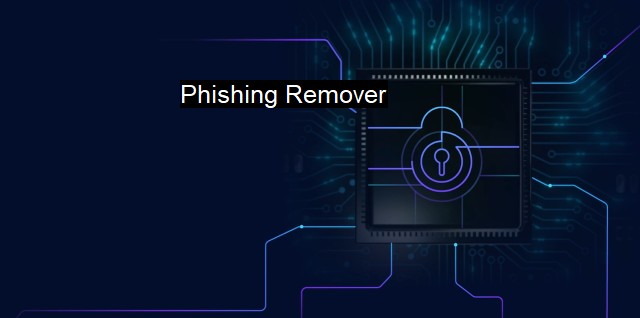What is Phishing Remover?
Staying Protected: How Anti-Phishing Software Safeguards Against Cybercriminals' Fraudulent Tactics
Phishing Remover, often referred to as an anti-phishing tool, belongs to a category of cybersecurity software specifically designed to identify and thwart phishing attacks. Phishing is a fraudulent attempt to lure victims into unwittingly providing sensitive information, including passwords, credit card numbers, and social security numbers, by posing as a trustworthy entity. Cybercriminals typically employ deceptive emails or fraudulent websites as bait.There are various versions of phishing, but all typically run along a similar line. An unsuspecting person receives an email appearing to originate from an institute they trust—a bank, government entity, or popular social media platform. The message contents create a sense of urgency, convincing the recipient to visit a seemingly legitimate website and input their sensitive account information. As they furnish their details, the perpetrators behind the screen collect this information for their gain.
The aftermath of these attacks is often devastating—identity theft, unauthorized bank transactions, and various other forms of personal loss. Hence, it's crucial to have a defense mechanism in place, a role brilliantly played by Phishing Removers.
Phishing Removers or anti-phishing tools tirelessly filter through heaps of information coming into and going out of your system to detect potential phishing threats. Their algorithms identify the common patterns associated with phishing techniques to prevent infiltration. the software can quickly alert the user concerning suspicious emails or deceptive links. The primary goal of a Phishing Remover is to shield sensitive user data from prying eyes.
Features such as the ability to scan real-time traffic, monitor DNS settings, identify malicious scripts, and determine fingerprint images of phishing web pages significantly bolster the overall protection offered. Gradual learning further strengthens these tools. The more phishing attempts they obstruct, the more robust they get in detecting newer, more sophisticated attacks. Cybersecurity companies are increasingly incorporating AI and machine learning capabilities to make phishing removers more potent and quick in identifying phishing attacks.
Besides detection, Phishing Removers also have the capability of "removing" the phishing threats. In the context of phishing remover software, 'removing' generally refers to the process of neutralizing a threat, whereby the software either deletes or blocks the suspicious content before it can harm the system.
What sets Phishing Removers apart from traditional antivirus software is their specialization. While antivirus software is more generic, offering protection against a broad range of threats—including malware, Trojans, spyware—the Phishing Remover is phishing-specific. They may thus be more adept and responsive at countering phishing attacks, which are rapidly becoming one of the biggest cybersecurity threats.
As the cyber criminals continuously adapt and create more sophisticated phishing techniques, it has become vital to keep phishing removers updated, ensuring they're always ready to combat the latest threats.
On a broader scale, all users, whether individuals or businesses, need to ensure the safety and integrity of their valuable data. The recent surge in remote working culture only goes on to emphasize the critical importance of having robust cybersecurity tools such as Phishing Removers.
While this software can enact an effective wall-up mechanism against phishing, user awareness about the attacks’ nature and avoidance is equally pertinent. This includes opening emails from trusted sources, reporting suspicious emails up-front without clicking on any links, using strong, unique passwords and not sharing sensitive data.
Phishing Removers gain their relevance from a blend of technological advancement and evolving cyber threats. They are key instruments enabling safer digital communication, commerce, and data protection. Their role in maintaining our online safety will only continue to grow with the progression of the digital era.

Phishing Remover FAQs
What is phishing and how does it affect cybersecurity?
Phishing is a form of cyber attack where a hacker attempts to trick individuals into divulging sensitive information such as passwords or bank account details. Its impact on cybersecurity can be devastating as it can expose confidential data and leave individuals vulnerable to identity theft or financial fraud.How does a phishing remover work?
A phishing remover is a type of antivirus software that specializes in detecting and removing phishing attacks from emails and websites. It works by using advanced algorithms and heuristics to analyze emails, links, and attachments for suspicious activity. Once it detects a potential phishing attack, it immediately alerts the user and either removes the email or blocks access to the malicious website.What are the benefits of using a phishing remover?
Using a phishing remover can help protect individuals and organizations against cyber attacks that attempt to steal personal information or money. It provides an extra layer of security by detecting and removing phishing emails and links before they can cause damage. This saves time and money that would otherwise be spent repairing the damage caused by a successful phishing attack.Does a phishing remover provide complete protection against cyber attacks?
While a phishing remover provides significant protection against phishing attacks, it cannot guarantee complete safety against all cyber threats. Hackers are constantly developing new techniques to circumvent security measures, and some attacks can go undetected. Therefore, it is important to still practice common sense and use caution when clicking on emails or links, even when a phishing remover is in use.| | A | | | B | | | C | | | D | | | E | | | F | | | G | | | H | | | I | | | J | | | K | | | L | | | M | |
| | N | | | O | | | P | | | Q | | | R | | | S | | | T | | | U | | | V | | | W | | | X | | | Y | | | Z | |
| | 1 | | | 2 | | | 3 | | | 4 | | | 7 | | | 8 | | |||||||